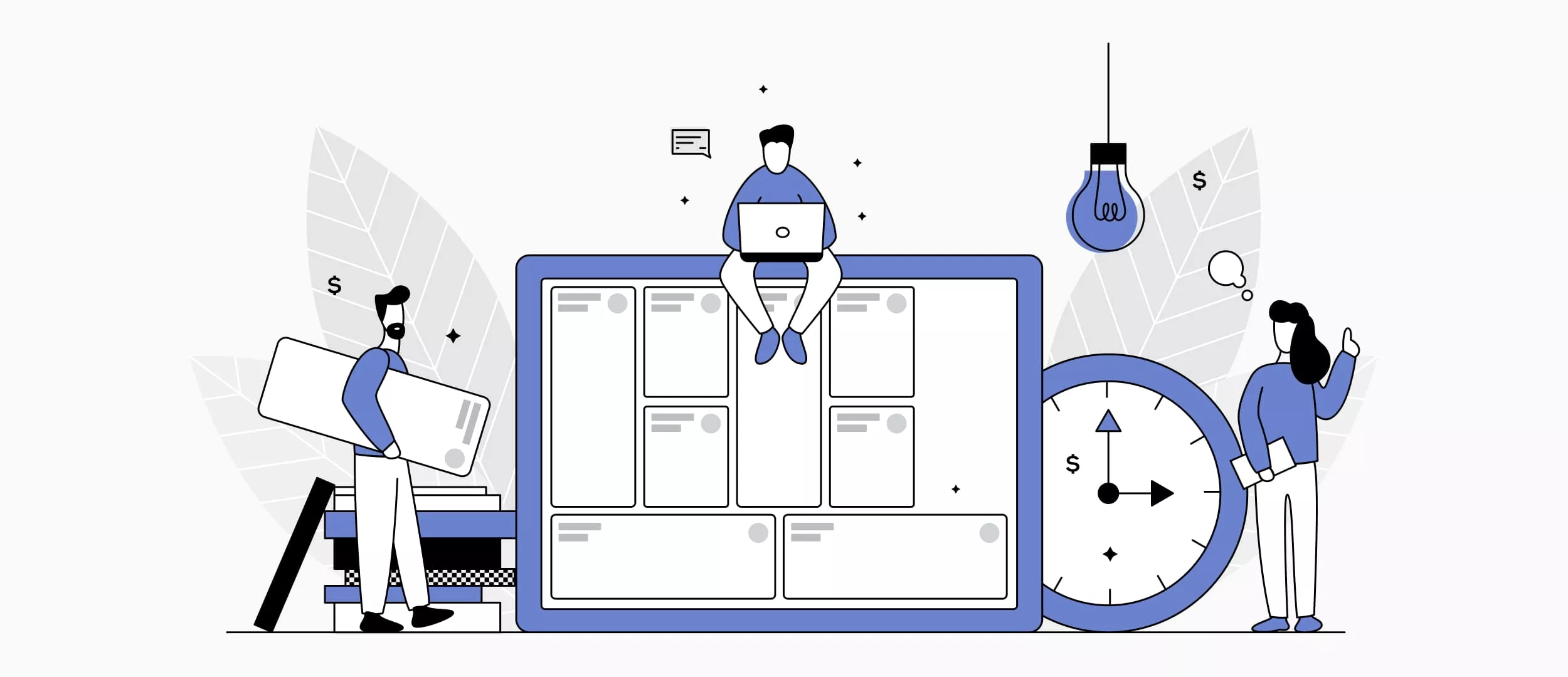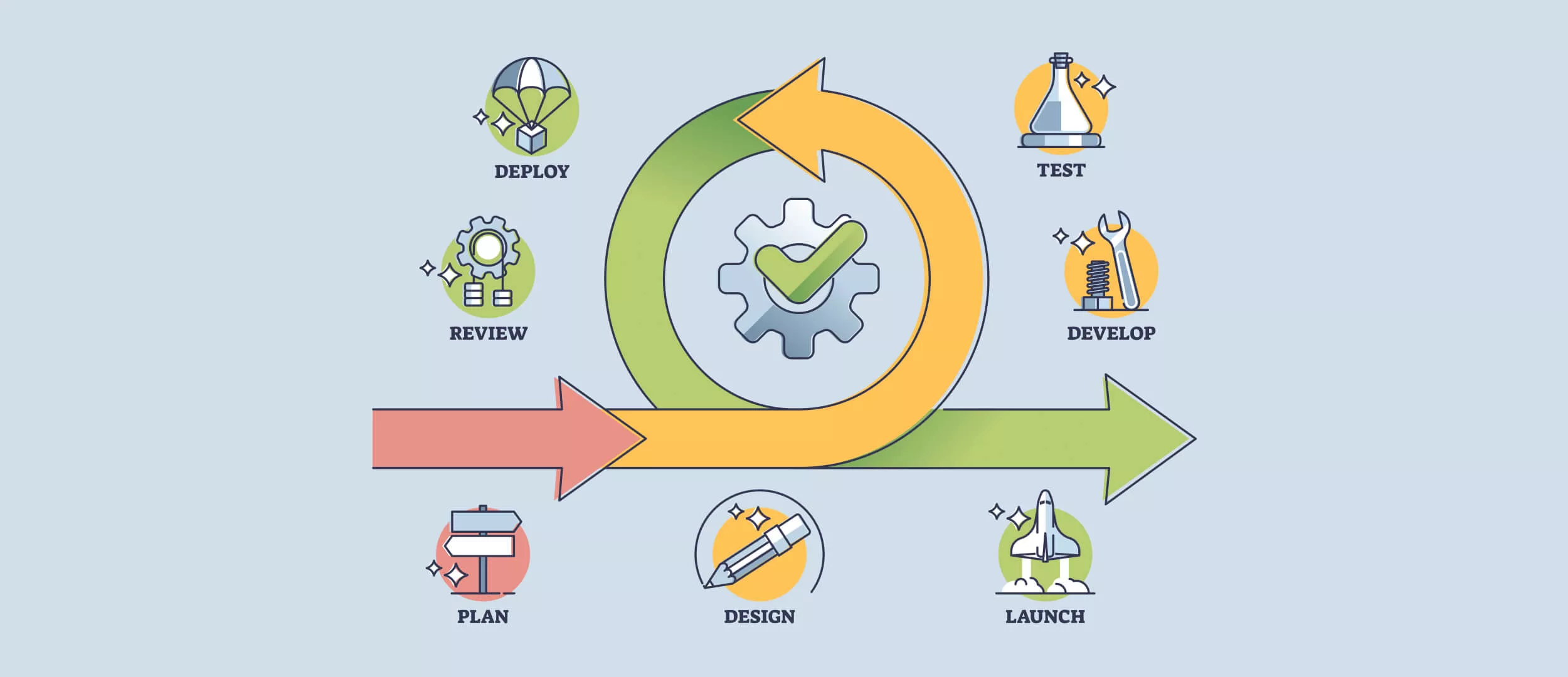
The world of IT is boosted with abbreviations. Today, let’s talk about one such abbreviation that stands for the software development lifecycle - SDLC meaning the process of managing a project from conception to retirement. The SDLC is a systematic approach to software development that includes the stages of planning, development, testing, and maintenance.
The lifecycle of software development is as complex and varied as the products themselves. Whether you're building an app for a business or creating a new piece of hardware, your project will have its own unique set of SDLC phases that are defined by both the capabilities of your team and the obstacles you face in getting started.
In this article, we'll go over the meaning of SDLC, including its stages and why they matter. We will also explain the software development life cycle in detail.
With our extensive expertise, Stfalcon can help you implement the right SDLC methodology tailored to your project's needs, ensuring an efficient development process and successful outcomes.
Want a web app that does more?
Let's build a solution that's smart, sleek, and powerful.
Alina
Client Manager

The Importance of the System Development Life Cycle
Now you know what an SDLC is. But why should you pay attention to it? The system development life cycle provides a roadmap for your organization to stay on track when it launches and plans to execute new software or systems.
It is an organized visual representation of the software development process. It is used to define the stages and steps involved in developing software applications, websites, and other digital products.
The SDLC definition assumes that it describes each stage of the project, analyzes its risks, and points out opportunities. It also provides recommendations for improving productivity and quality while minimizing costs. Overall, it makes the entire engineering process more efficient.
SDLC Stages Explained
Remember that SDLC is an abbreviation for Software Development Life Cycle? Like any life cycle, it has its own stages of development.
At different stages of the system development lifecycle, the team performs different actions to achieve goals and deliverables until the process is complete and the team moves on to the next stage. Whether you deal with a simple app or a complex enterprise-level development project, the goal of each stage is to create a product that meets or exceeds customer needs in terms of quality, usability, and performance.
At each stage, you will be tasked with
- writing user stories according to your requirements
- creating prototypes so you can test them
- creating code that ensures everything works properly together
- deploying your app in a production environment where users will see it live.
So, what are the 5 stages of the SDLC? Let's take a closer look at each of them.
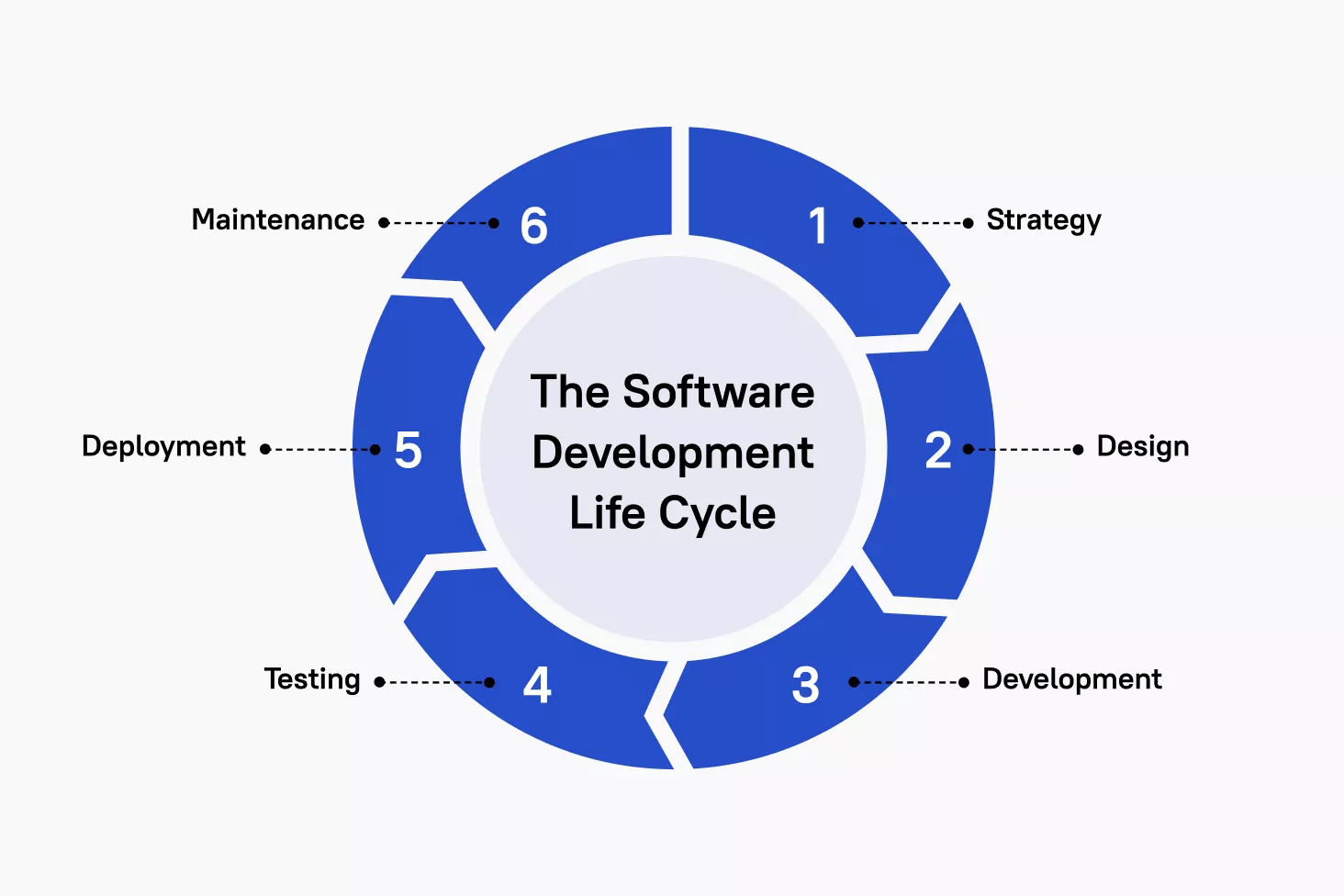
Discovery
The first step in development is to gather requirements from various stakeholders such as customers, users, managers, etc. At Stfalcon, we call this the Discovery phase and use this initial step to gain a deep understanding of the industry, our client's business, and the product's target audience.
The development team then uses the requirements to create a series of documents and diagrams to further efficiently work on the project.
Design
This involves considering all aspects related to your project, including user experience (UX) design, technical feasibility, and budget constraints. The goal of this stage is to create an initial design document that includes all of these things along with relevant tasks/deliverables such as wireframes or mockups.
Development
At this stage, developers create code for the software project based on the specifications from SDLC stages 1 and 2. You should include everything you need for testing before deployment. This is to avoid performance issues later on due to a lack of resources required during the implementation phase. So make sure everyone involved knows exactly what needs to be done before you start working on these parts of the project.
Developers also test their work to make sure it meets expectations before handing it over to QA testers for additional testing.
Testing
At this stage, QA testers conduct comprehensive testing of software applications and systems to make sure they meet the customer's needs. At this stage, you verify all requirements, fix bugs found during testing, and make sure everything works smoothly.
Ensure that everything works as expected once deployed to the production environment.
Release
The release stage is the last one before the client receives the product. It is at this stage that all customer specifications are met, including quality and functionality. At this stage, you get feedback from the client about the release and fix any issues that are found. At this stage, we move on to the network implementation stage.
Maintenance
In addition to the 5 stages of SDLC life cycle described above, we would like to talk about one more. This stage involves regularly updating your software products with bug fixes and new features to keep them relevant and meet customer needs for a long time.
It's an important part of any project management because it ensures that you can provide ongoing support to your customers even after the initial release date has passed.
Commonly used SDLC methodologies
There are many different SDLC methodologies you can use. Some are more popular than others, but they all have their pros and cons. Let's see which ones are the most common.
Agile
One of the most popular software development lifecycle models is Agile. The three-tiered Agile SDLC is a philosophy and set of principles that provide a framework for creating software products and services. It is a software development method that encourages the use of short cycles and frequent feedback.
Agile developers prefer to work in more agile environments where collaboration between teams is encouraged rather than working in isolation.
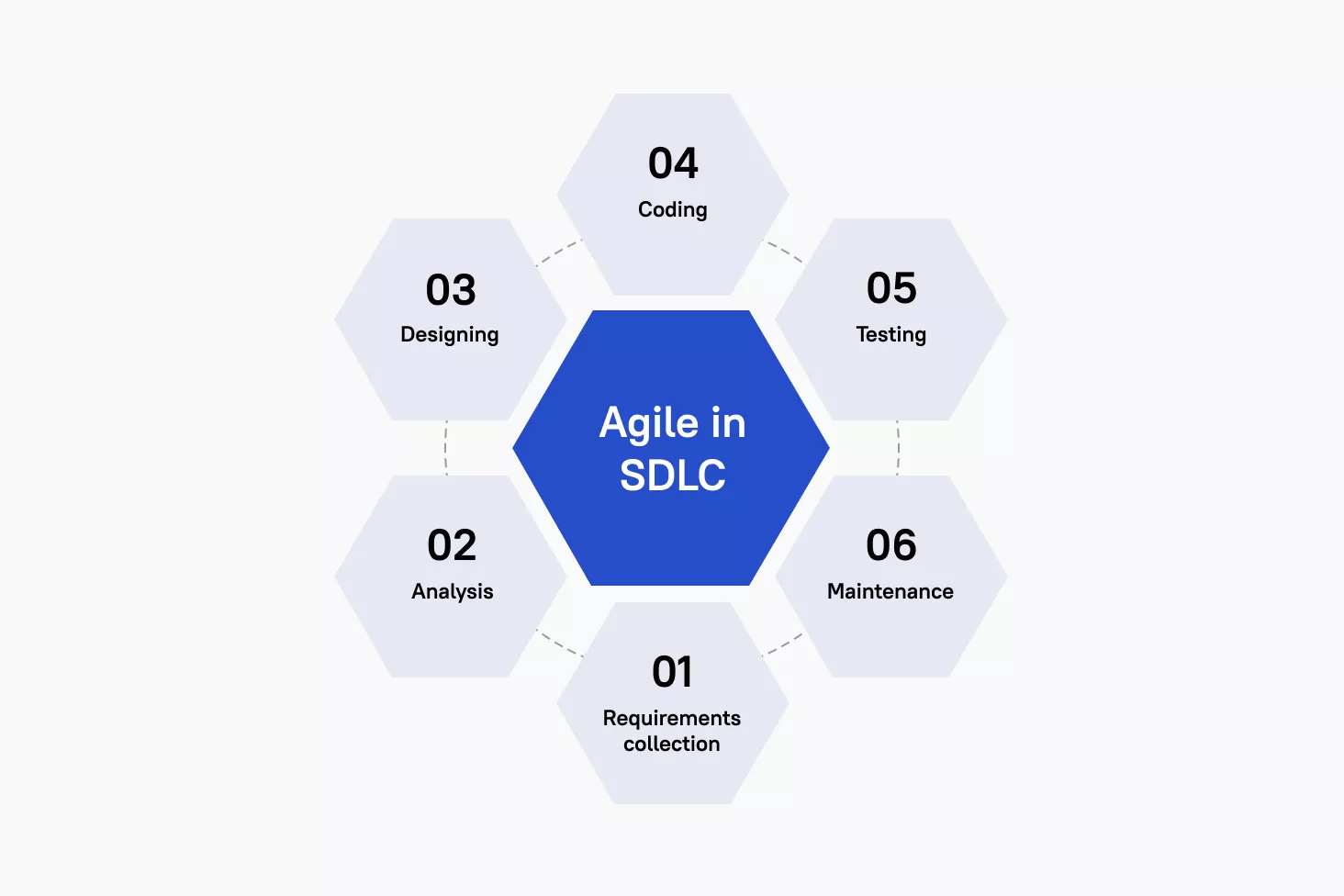
In other words, Agile emphasizes flexibility to achieve success faster and more efficiently than traditional approaches such as Waterfall or iterative development. Agile methods are commonly used by organizations looking to embrace change, increase productivity, and reduce costs.
An agile development approach can be very useful for any organization or team looking to improve their processes. Here are just a few of the benefits of using an agile approach:
- Improved communication between developers and business users
- Enhanced collaboration between teams
- Improved quality assurance
- Reduced costs
- Faster time to market
- More efficient use of resources.
Waterfall
Waterfall is one of the software development lifecycle models that involves a step-by-step process. It's all about planning so that you never have any surprises along the way. The definition of this model was first introduced by Robert Martin in his book "Agile Software Development: Principles, Patterns, and Practices. He described it as follows:
“In the waterfall model, requirements are gathered up front, detailed design comes at the end, and then coding begins.”
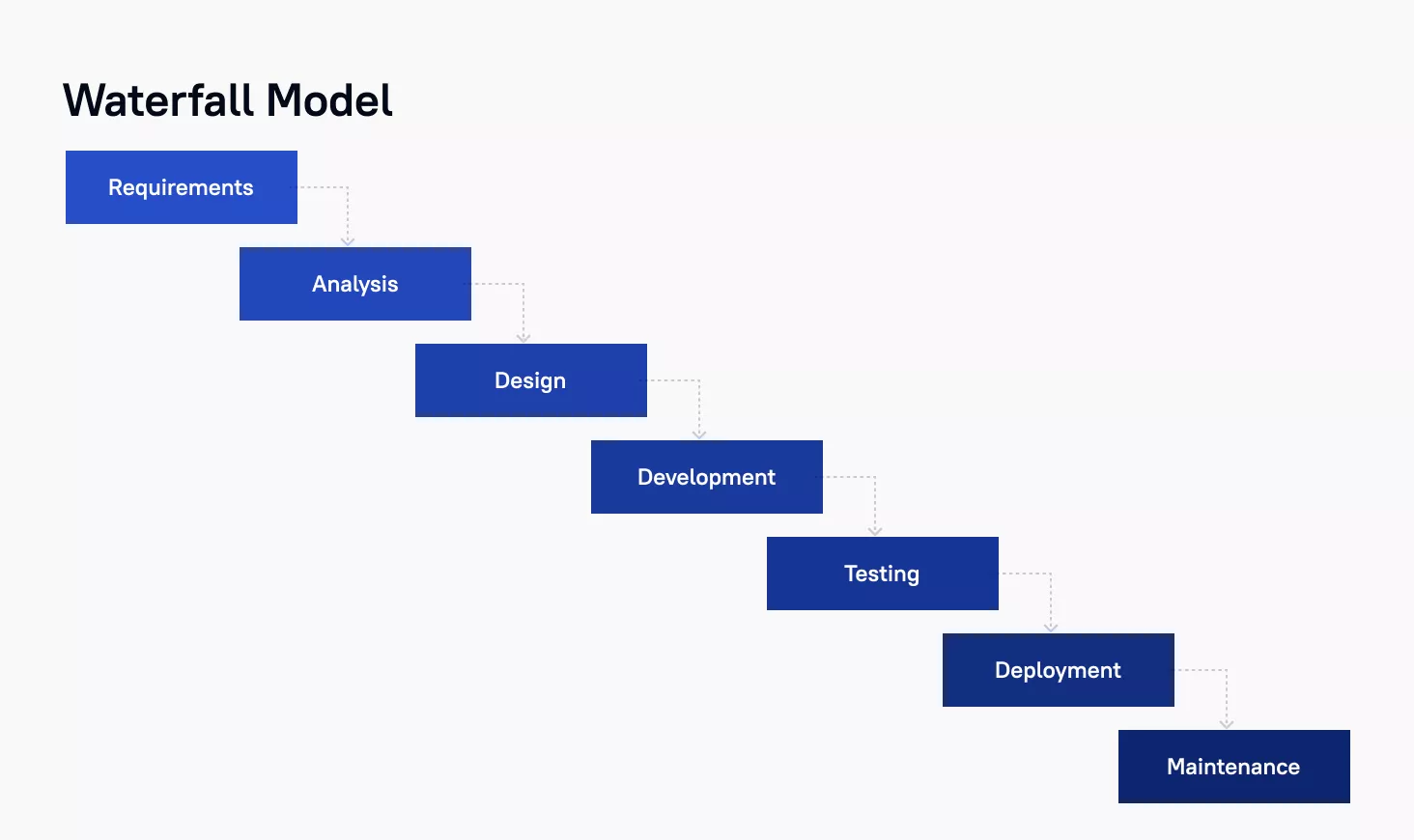
It is a sequential process in which requirements are gathered, analyzed, and then realized through activities that occur in a predefined order. The main advantage of the Waterfall model is that it provides a clear roadmap for the project management team to follow during project implementation.
This model is criticized for being too rigid and inflexible. Nevertheless, there are still many organizations that use this approach because they believe that it provides them with more control over projects.
Advantages:
- A clear roadmap for project managers
- Easy to understand
- Provides a structured approach to project management
- Allows for better team coordination.
Iterative
Iterative is also known as the incremental model. Iterative development is a project management process that emphasizes working in stages or iterations. Iterative lifecycle models are based on the idea that the best solutions come from small incremental changes that are made throughout the product lifecycle.
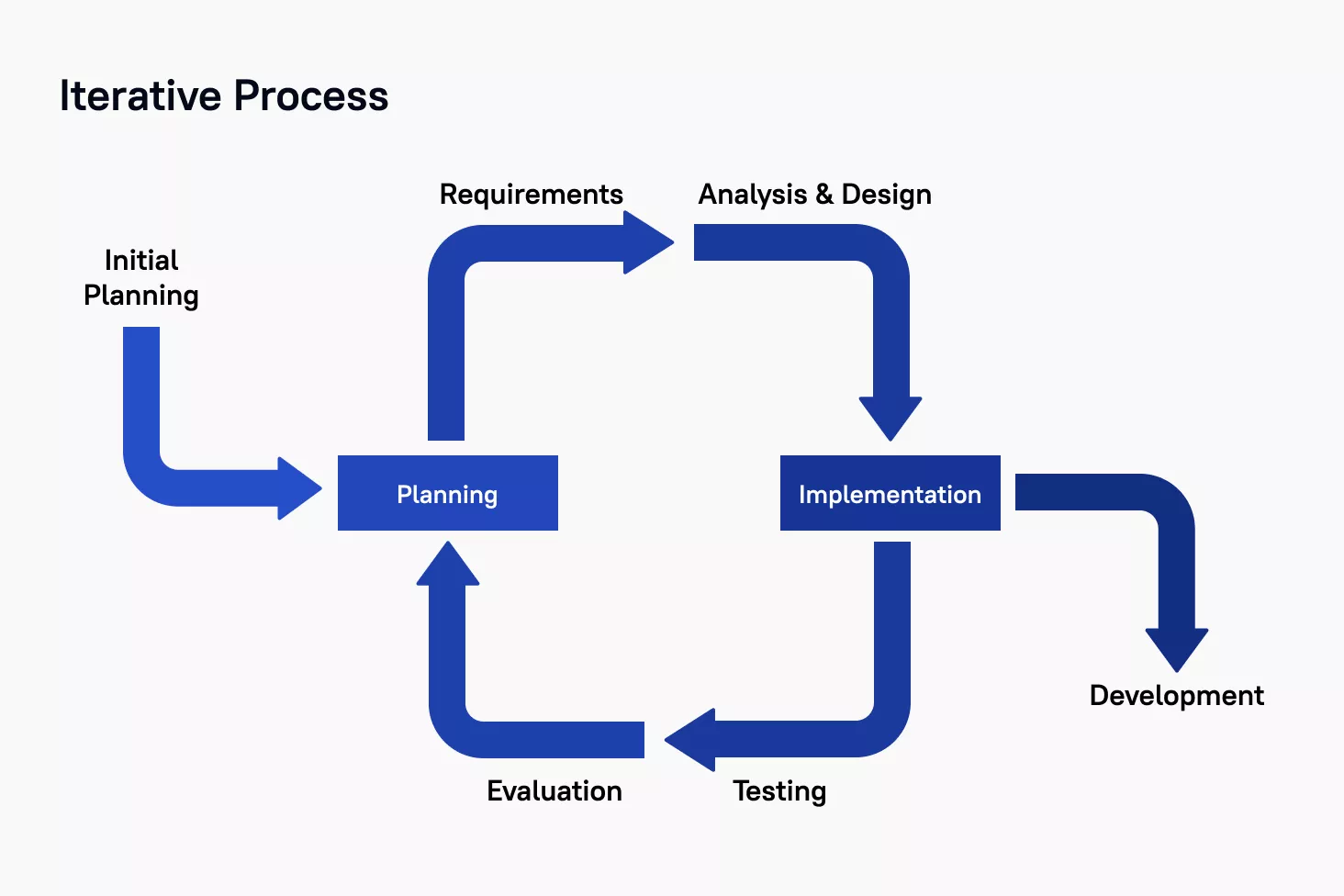
It is a software development methodology that involves repeatedly applying small changes to an existing system, as opposed to making large changes over and over again. Each iteration can last from one week to one month. And it can happen synchronously. The goal of each iteration is to develop and test a piece of software.
Iterations are usually planned in advance, but they can also be organized according to business or technical needs.
Iterative development is a good approach for projects that have many unknowns and risks, as it allows you to build in stages and identify problems as they arise. This approach is best for smaller projects because it allows you to test new features without having to wait until everything is complete. You can also make changes to existing code during this phase.
Benefits:
- Smaller scope
- Better understanding of requirements
- Easier testing
- Ability to fix bugs at an early stage
- Implementation with low overhead.
Spiral
Spiral development is very similar to iterative development. However, instead of making small changes to an existing product, spiral development involves creating new products from scratch using an iterative approach. It consists of a series of steps that follow each other in a cyclical fashion.
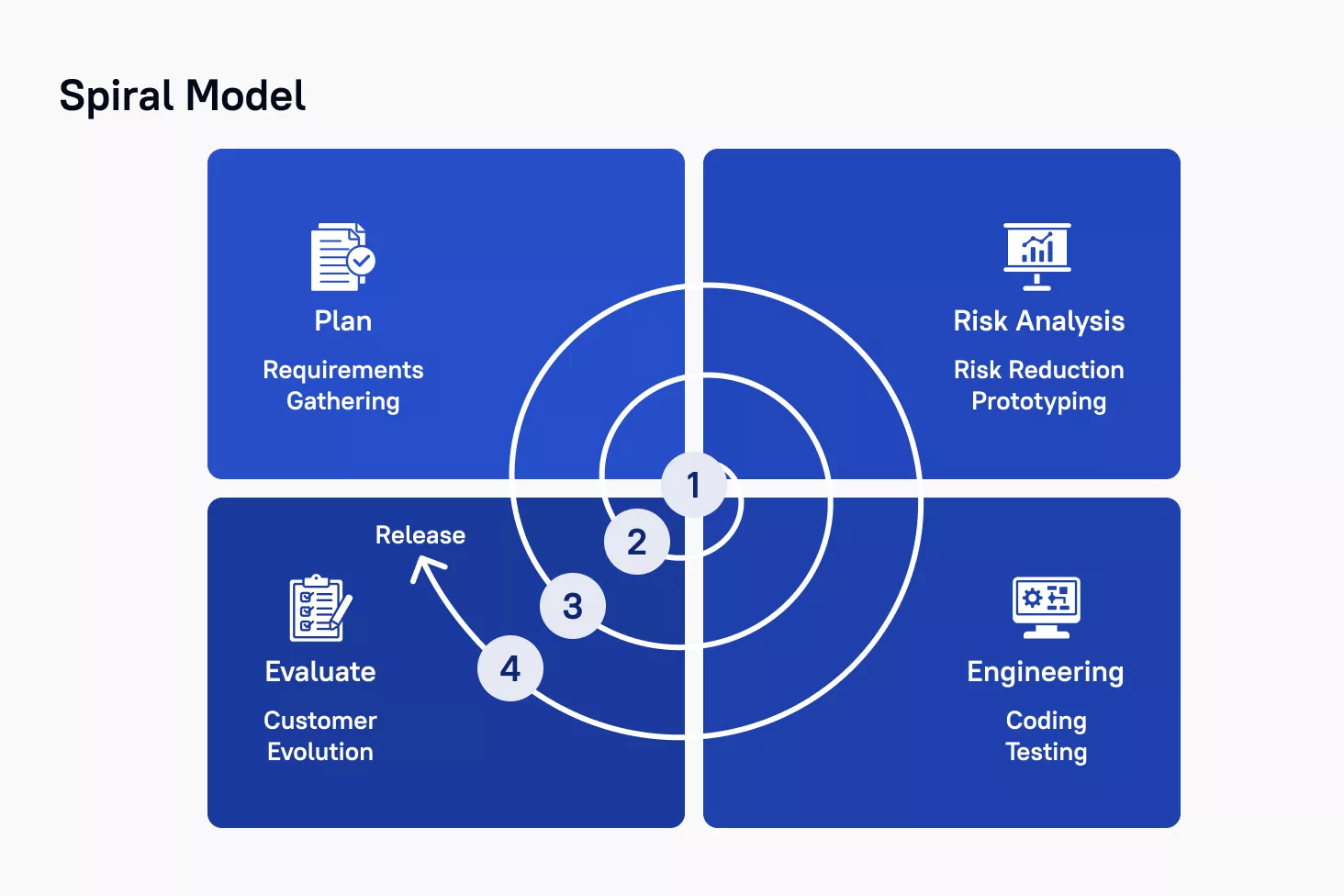
These software lifecycle models are based on the idea of continuous improvement. They include a series of steps that are repeated until the desired result is achieved. Spiral SDLC models are often used in the development of large-scale systems. They also work well when solving complex problems.
Advantages:
- Allows for continuous improvement and iteration
- Ensures that the system will meet the user's needs
- Allows for continuous improvement
- Helps avoid getting stuck in one particular phase of the project.
V model
V-shaped lifecycle models use a series of phases that follow an upward flow to form a V-shape. The horizontal axis represents time or project completion (from least to most complete), and the vertical axis represents abstractions (from coarsest grain to finest grain).
The V-model consists of five stages: Vision, Design, Implementation, Verification, and Maintenance. Each stage is divided into smaller tasks that are performed sequentially.
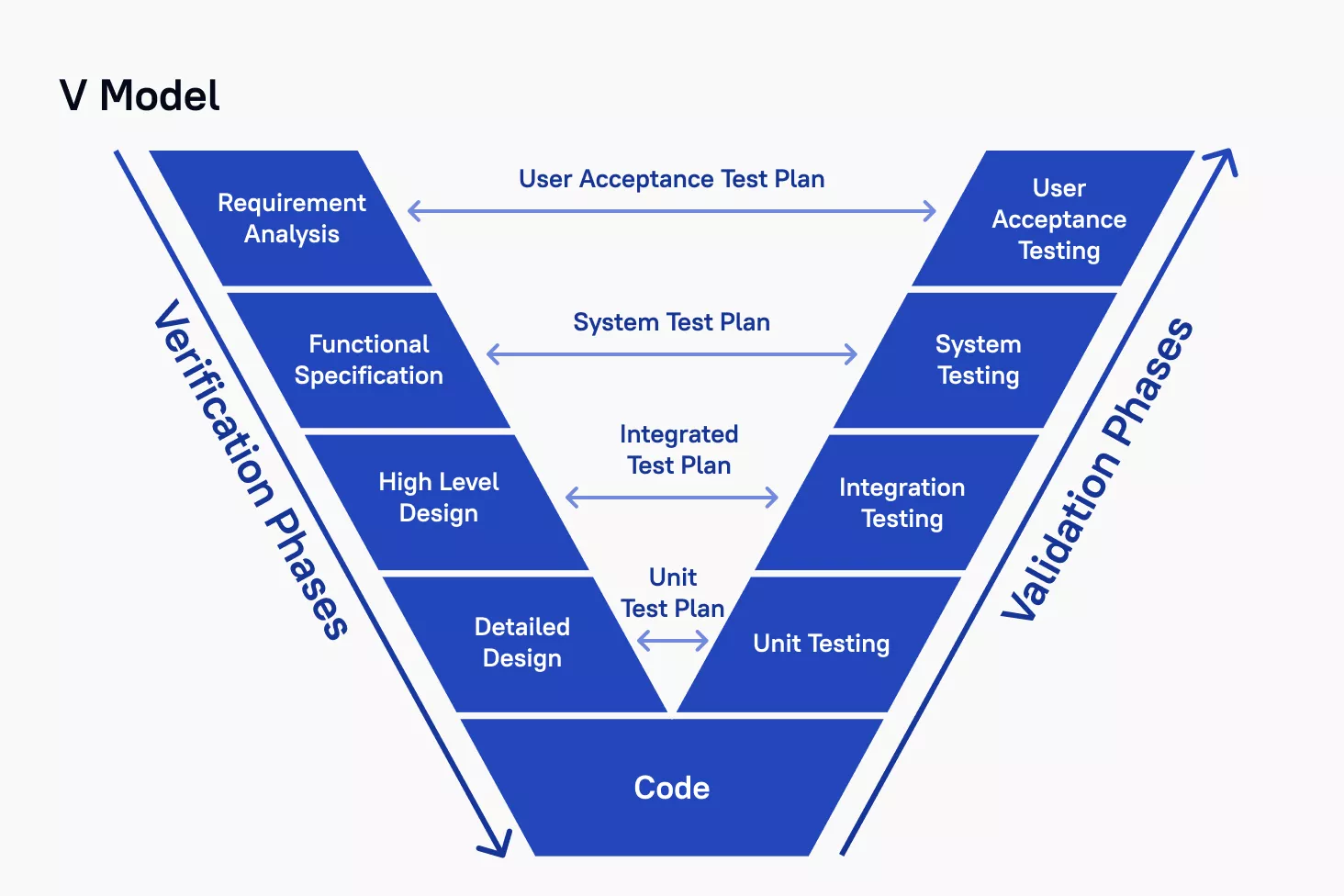
Benefits:
- The model ensures that the right people are involved throughout the life cycle
- Easier to track progress
- Easier to manage the scope of work
- Allows for better prioritization.
How to choose the right SDLC methodology for your project
It's not enough to know what the software development life cycle is. You also need to choose the right SDLC methodology. There are many different methodologies that you can find online, and each of them has its own strengths and weaknesses.
We've already covered some of them above. Now let's look at how to choose the right methodology for your project.
First, think about the size of the project. Do you need to develop a small solution? Or do you prefer to work on a large-scale application? If you are working on a small project, then you should consider using Scrum. Scrum is a framework that helps break down complex problems into manageable parts. You'll also find that it helps you focus on delivering value to your customers in an optimal way.
If you are developing a larger application, for example, a big and fast-paced e-commerce project, you may want to consider something else. A good example of this methodology is Extreme Programming (XP). XP is based on the idea that the best way to build software is to start from scratch. That is, instead of starting with a big pile of requirements, you start with a clean slate and create everything from scratch.
The spiral method is also a good choice for large projects. The iterative methodology is often used for smaller solutions.
Another thing to keep in mind when choosing a methodology is whether you want to focus on quality or speed. In general, agile methods emphasize fast delivery and continuous improvement. This means you can make changes as quickly as possible without worrying about something breaking.
On the other hand, if you prefer quality, you can choose a traditional approach such as Waterfall. Here you will have a fixed schedule and a set of clearly defined deliverables. With this in mind, you can decide which SDLC method is best for your project.
SDLC tools we use
To help you get started, here's a list of SDLC tools we use.
Workflow Management Tools
- JIRA. This is an issue tracking system designed specifically for agile teams. It allows you to track bugs, issues, stories, tasks, and more.
- Redmine. A flexible open source web application for project management that is cross-platform and works with various databases.
- ResourceGuru. A resource planning tool that allows you to quickly and flexibly assign tasks, distribute work among team members, and keep your project under control.
Continuous integration tools
- GitLab CI. As part of GitLab, it builds and tests software solutions every time a developer adds code to an application. The service provides automation, pipeline configuration management, security, and artifact storage in a single set of functions.
- Kubernetes. Another open source system we use to automate the deployment, scaling, and management of containerized applications.
- Firebase AppDistribution. This is a free service that allows developers to distribute an app installer to test groups using the Firebase console. It provides a holistic view of the beta testing program on iOS and Android, providing feedback from users before a new release.
- Testify. Testify is a solution that helps to develop, control, document, and analyze mobile application quality control processes. It helps to effectively optimize quality processes, gain insight into previously unknown process data, and continuously improve product quality.
Version control system
Version control services
- GitLab. This is an end-to-end open source development platform. It offers built-in version control, code review, issue tracking, and much more.
- GitHub - GitHub is a web-based version control service that makes it easy to store source code online.
- Bitbucket - Bitbucket is another cloud-based version control service. It offers unlimited private repositories and free public repositories.
Conclusion
So, the next time you find yourself in the middle of a project and wonder what to do next, don't worry! There are many tools and techniques to help you through any stage of the development process.
Remember: a successful software development project requires careful planning and attention to detail, which is exactly what we do at Stfalcon. If you don't follow these steps of the software development process, you may find yourself wasting time and money on projects that never get off the ground. To ensure that you get the best results, you need to think through every aspect of the project, or better yet, you need to trust the professionals. Contact us to discuss your project in detail, and together we can create a great app without worrying about the difficulties associated with its development.



